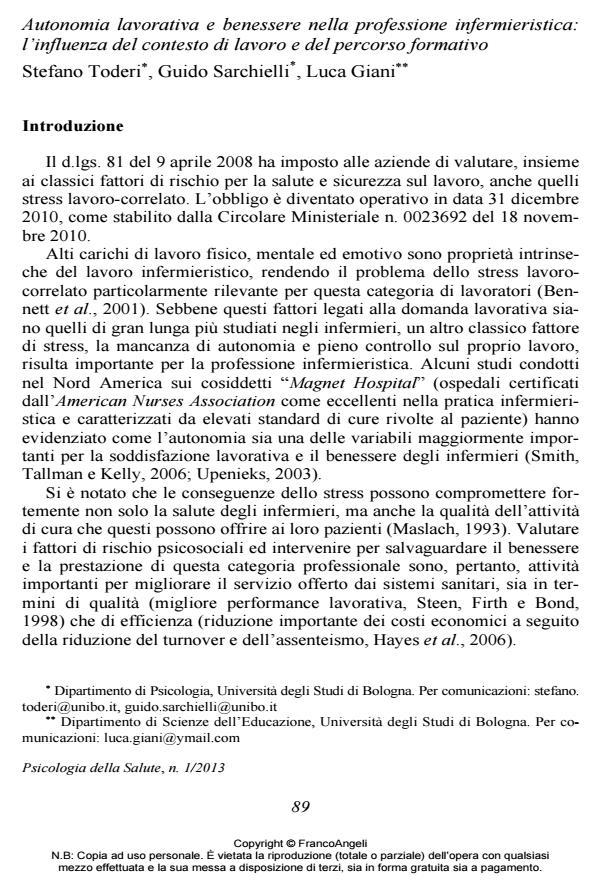Job autonomy and well-being in the nurse profession: the influence of the workplace and the training course
Journal title PSICOLOGIA DELLA SALUTE
Author/s Stefano Toderi, Guido Sarchielli, Luca Giani
Publishing Year 2013 Issue 2013/1
Language Italian Pages 22 P. 89-110 File size 465 KB
DOI 10.3280/PDS2013-001005
DOI is like a bar code for intellectual property: to have more infomation
click here
Below, you can see the article first page
If you want to buy this article in PDF format, you can do it, following the instructions to buy download credits

FrancoAngeli is member of Publishers International Linking Association, Inc (PILA), a not-for-profit association which run the CrossRef service enabling links to and from online scholarly content.
The lack of autonomy is a particularly important risk factor for the work well-being of nurses, especially after the reform that from the mid-90s has profoundly changed their professional profile. The goal of this research is to study the relationship between job autonomy and wellbeing of nurses, that are considered as an heterogeneous category on the base of workplace (wards) and type of training received (training course). The data obtained through a questionnaire administered to 69 nurses confirmed the moderating effect of both variables. Autonomy predict well-being only in the geriatricrehabilitation ward and mainly for nurses of professional training course. The results, that confirm the necessity to consider nurses as an heterogeneous category, are discussed concerning the different meaning that autonomy has in different wards and the different value that nurses with particular personal characteristics can attribute to it. These differences are fundamental in order to plan targeted interventions to reduce risk of workrelated stress.
Keywords: Nurses, process of professionalization, job autonomy, affective well-being, moderation analysis, work related stress
- Stress-Preventive Management Competencies, Psychosocial Work Environments, and Affective Well-Being: A Multilevel, Multisource Investigation Stefano Toderi, Cristian Balducci, in International Journal of Environmental Research and Public Health /2018 pp.397
DOI: 10.3390/ijerph15030397 - Reducing psychosocial risks through supervisors' development: A contribution for a brief version of the “Stress Management Competency Indicator Tool” Stefano Toderi, Andrea Gaggia, Cristian Balducci, Guido Sarchielli, in Science of The Total Environment /2015 pp.345
DOI: 10.1016/j.scitotenv.2015.02.082 - Il benessere nei vigili del fuoco volontari: la mindfulness come risorsa psicologica Piergiorgio Argentero, Ilaria Setti, in PSICOLOGIA DELLA SALUTE 2/2015 pp.101
DOI: 10.3280/PDS2015-002006
Stefano Toderi, Guido Sarchielli, Luca Giani, Autonomia lavorativa e benessere nella professione infermieristica: l’influenza del contesto di lavoro e del percorso formativo in "PSICOLOGIA DELLA SALUTE" 1/2013, pp 89-110, DOI: 10.3280/PDS2013-001005